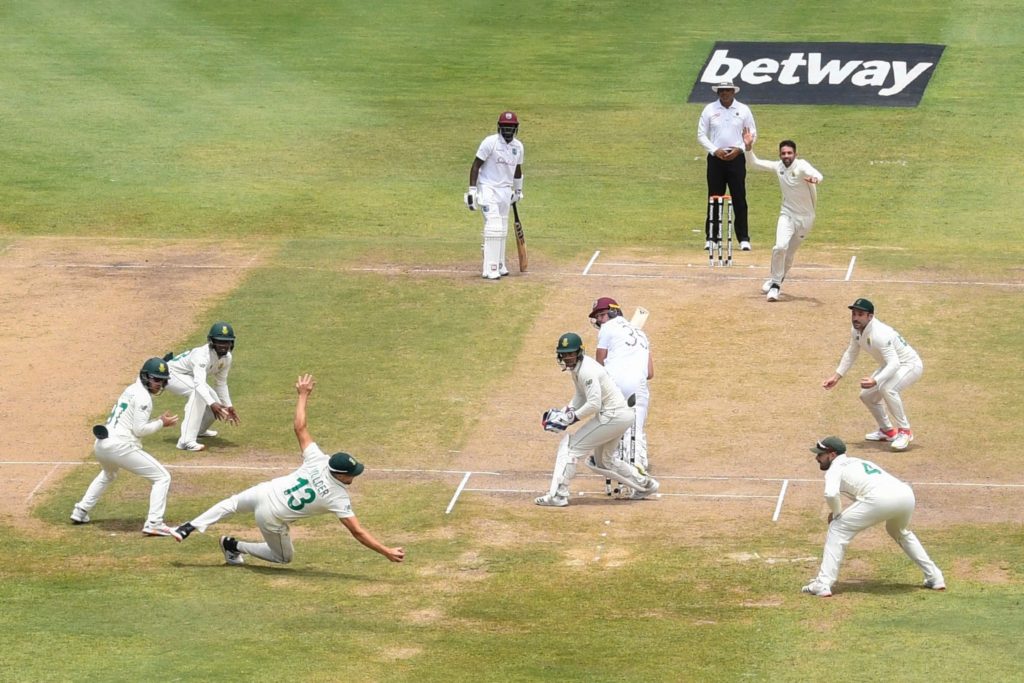Following the Proteas’ 2-0 series win over the West Indies, CARL LEWIS covers the biggest talking points and takeaways from the Test matches.
Fast-bowling unit can be world class
The commanding series win must be attributed to the three fast bowlers because they, alongside Quinton de Kock, saved some of the Proteas batting blushes with their intense and relentless probing of the Windies batting lineup, which essentially shifted the series into a one-sided affair. The leader of the attack, Kagiso Rabada (11 wickets) picked up the most wickets in the series; his deputies, Lungi Ngidi and Anrich Nortje, also had their series moments taking eight wickets each. Ngidi’s highlight was his second Test five-for in the first Test while Nortje was South Africa’s best and most consistent bowler in that match taking wickets in each of the innings.
There is no doubt that Rabada is world class but his form before the series was not up to his usual (crazily) high standards. His five-for in the first Test would’ve put a collective smile on South African faces. He continued his controlled aggressive approach in the second Test and was rewarded with the player of the match. If this fast-bowling trio can remain fit, there is potential for them to write their own history and make a real impact on the international scene as others have done before them.
Maharaj remains Proteas’ undisputed spinner
I don’t think there is another South African player who is as consistently overlooked and underrated as Keshav Maharaj. In a series dominated by the Proteas pace attack, Maharaj played his role to perfection. The left-arm spinner not only held up an end but he struck at crucial stages to compound the Windies’ batting problems. He was the perfect foil for the quicks and eventually ended on nine series wickets, which turned out to be the second highest behind Kagiso Rabada.
Although, the headlines will surely be about his hat-trick on day four on the second Test. Maharaj took 5-36 on the day but, most importantly, he became the first South African to bag a hat-trick since readmission and the second ever after Geoff Griffin’s against England at Lord’s in 1960. This series should prove, again, that Maharaj deserves his place in the Test side because of his capacity to take wickets and add value on whatever pitch conditions he faces.
Still a batting spot up for grabs
Although both Test ‘rookies’ Keegan Petersen and Kyle Verreynne showed glimpses of why they were selected, neither made the required statement to plug the Faf du Plessis-sized hole. And this is to be expected because of the growing pains and learnings that come with Test cricket. It would be foolish and wrong to write off any cricketer after just two Tests. But the fact remains there is still a batting spot up for grabs if either of them wants to take it or it could be someone’s from outside the squad.
Petersen batted three all series and looked comfortable at Test level with his scores of 19, 7 and 18. Verreynne was caught playing a loose shot in the first Test, but in the second he really dug his heels in for a gutsy 27 off 87 balls in the first innings but was out for six in the second. Unfortunately, these scores don’t provide any clear answers and therefore the search for a long-term Proteas middle-order candidate is still ongoing.
De Kock still the Proteas’ best
Quinton de Kock scored the most runs in the series (237) and almost 100 runs more than second-placed South African Rassie van der Dussen (125). He was the major difference between the two batting units. Before the series, De Kock was going through one of the toughest batting periods of his career, lacking his usual free-scoring swagger and it was very noticeable because the Proteas’ success is so heavily dependent on him performing. So, it must’ve been a huge relief for him and the coaching staff when he scored his 141* in the first innings.
It was his sixth Test century and one of his best, no doubt – he was head and shoulders above any other batter (or player) on that pitch. The ‘picture’ that showcases how good he is could not have been clearer and he continues to be the Proteas’ best batsman despite the recent struggles. He was unlucky to fall four runs short of another century in the second Test in what was yet another indicator of how easy the game is for De Kock when in form.
Photo: AFP






